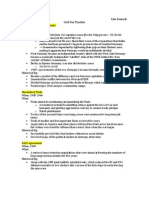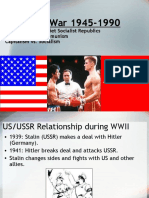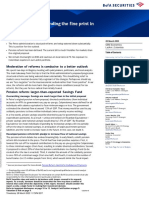0 ratings0% found this document useful (0 votes)
34 viewsIntroduction To The Cold War
Introduction To The Cold War
Uploaded by
Surabhi ShastryThe Cold War developed between the United States and Soviet Union after WWII over differences in their political and economic ideologies of democracy and communism. It lasted from 1945-1991 and involved conflicts between communist and anti-communist states supported by the USSR and US, respectively. Both sides felt their national survival was at stake. Several key events in the early Cold War period that contributed to tensions included the alliance between the US and USSR in WWII, their differing goals for postwar Europe, economic and military alliances that divided Europe, communist rebellions in Greece and Turkey prompting US intervention, the nuclear arms race, the Berlin Crisis, the Korean War showing communism as a threat, and the Soviet invasion of Hungary increasing US fears of communism.
Copyright:
© All Rights Reserved
Available Formats
Download as PDF, TXT or read online from Scribd
Introduction To The Cold War
Introduction To The Cold War
Uploaded by
Surabhi Shastry0 ratings0% found this document useful (0 votes)
34 views20 pagesThe Cold War developed between the United States and Soviet Union after WWII over differences in their political and economic ideologies of democracy and communism. It lasted from 1945-1991 and involved conflicts between communist and anti-communist states supported by the USSR and US, respectively. Both sides felt their national survival was at stake. Several key events in the early Cold War period that contributed to tensions included the alliance between the US and USSR in WWII, their differing goals for postwar Europe, economic and military alliances that divided Europe, communist rebellions in Greece and Turkey prompting US intervention, the nuclear arms race, the Berlin Crisis, the Korean War showing communism as a threat, and the Soviet invasion of Hungary increasing US fears of communism.
Original Title
Introduction to the Cold War
Copyright
© © All Rights Reserved
Available Formats
PDF, TXT or read online from Scribd
Share this document
Did you find this document useful?
Is this content inappropriate?
The Cold War developed between the United States and Soviet Union after WWII over differences in their political and economic ideologies of democracy and communism. It lasted from 1945-1991 and involved conflicts between communist and anti-communist states supported by the USSR and US, respectively. Both sides felt their national survival was at stake. Several key events in the early Cold War period that contributed to tensions included the alliance between the US and USSR in WWII, their differing goals for postwar Europe, economic and military alliances that divided Europe, communist rebellions in Greece and Turkey prompting US intervention, the nuclear arms race, the Berlin Crisis, the Korean War showing communism as a threat, and the Soviet invasion of Hungary increasing US fears of communism.
Copyright:
© All Rights Reserved
Available Formats
Download as PDF, TXT or read online from Scribd
Download as pdf or txt
0 ratings0% found this document useful (0 votes)
34 views20 pagesIntroduction To The Cold War
Introduction To The Cold War
Uploaded by
Surabhi ShastryThe Cold War developed between the United States and Soviet Union after WWII over differences in their political and economic ideologies of democracy and communism. It lasted from 1945-1991 and involved conflicts between communist and anti-communist states supported by the USSR and US, respectively. Both sides felt their national survival was at stake. Several key events in the early Cold War period that contributed to tensions included the alliance between the US and USSR in WWII, their differing goals for postwar Europe, economic and military alliances that divided Europe, communist rebellions in Greece and Turkey prompting US intervention, the nuclear arms race, the Berlin Crisis, the Korean War showing communism as a threat, and the Soviet invasion of Hungary increasing US fears of communism.
Copyright:
© All Rights Reserved
Available Formats
Download as PDF, TXT or read online from Scribd
Download as pdf or txt
You are on page 1of 20
The Cold War
Cold War (definition)
• Not a direct battle but a conflict that
developed between the United States and
the Soviet Union after World War II.
• This was a battle of democracy and
communism. It lasted from 1945-1991.
If the US & USSR never fought
directly, why do we call it a war?
• Many wars WERE fought between the
Communists (supported by the USSR) and the
anti-Communists (supported by the US)
• Both will compete for power using their
political, economic, and military clout in the
war.
• Both sides felt their national survival was at
stake.
How did the Cold War begin?
• Today you will be reading about several events
which contributed to the development of the Cold
War.
• In groups and in breakout rooms, you will be
assigned one of the major events in the early Cold
War period. With your group:
– Read the description.
– Answer the following question:
• How did this event contribute to the
development of the Cold War?
• Use details and examples from the reading to
support your response.
How did this event contribute to the
development of the Cold War?
Event A: The WWII
Alliance Between the
Soviet Union and the
United States
Event A: The WWII Alliance Between
The Soviet Union and The United States
• After WWII, conflict returned with these nations
because of differences in beliefs.
• Their ideologies are different and this made each
nation suspicious of the other.
• Each nation had different goals postwar for
Eastern Europe.
– The US wanted nations to be free.
– The Soviet Union wanted to control them as a “buffer,”
or protection.
How did this event contribute to the
development of the Cold War?
Event B: Economic and
Military Alliances After
World War II
Event B: Economic & Military
Alliances After WWII
Economic Alliances:
Marshall vs Molotov Plans
• The US believed financial aid was necessary to
help Western Europe recover after the war It would
also stop communism from spreading beyond the
USSR’s border.
• The Soviet Union believed that the plan only served
US’ economic interests (capitalism) and it
undermined their power in Europe.
Military Alliances:
NATO and Warsaw Pact introduce the establishment of
defensive armies throughout Europe.
How did this event contribute to the
development of the Cold War?
Event C: Communist
Rebellions in Greece
and Turkey
Event C: Communist Rebellions
in Greece and Turkey
• The rebellion inspired the Truman Doctrine.
• This justified the US intervening in regional
conflicts in the name of stopping the spread of
communism.
• The rebellion of Greece and Turkey were one
of the first indirect confrontations between the
US and the Soviet Union.
How did this event contribute to the
development of the Cold War?
Event D: The
Development of Nuclear
Weapons
Event D: The Development of
Nuclear Weapons
• Both countries had nuclear weapons and
this positioned them as “super powers”
• Each country kept adding more and more
weapons to keep the other “in check,” and
this was known as an arms race.
How did this event contribute to the
development of the Cold War?
Event E: The Berlin
Crisis
Event E: The Berlin Crisis
• The Soviets set up a blockade of Berlin cutting
off residents to all supplies including fuel,
power, and food (June 1948).
• By August, the US began flying supplies to
Berlin in an attempt to aid West Berlin without
starting an armed conflict with USSR.
• Stalin reopened the city on May 12, 1949 to
supplies but the city remained divided. The
USSR built a wall by 1961 separating the city.
How did this event contribute to the
development of the Cold War?
Event F: The Korean
War
Event F: The Korean War
• War confirmed American belief that the spread
of communism in Asia was a serious threat.
• China was a communist country.
• Korea was divided: North--Communist & South
was democratic.
• North Korea invaded South Korea.
• United Nations troops intervened and the war
ends in a stalemate.
• The Cold War was now a global conflict.
How did this event contribute to the
development of the Cold War?
Event G: The Soviet
Invasion of Hungary
Event G: The Soviet Invasion of
Hungary
• By ruling Eastern Europe through force and
repression, the Soviet Union increased American
belief that communism had to be stopped at all
costs.
• The Soviet Union’s brutal suppression of
Hungarian uprisings confirmed Americans’ worst
feats and increased the already substantial
hostilities between the US and USSR.
What was the United States Response to
the Soviet Union during the Cold War?
The Response of the United States
• Containment: (Cornerstone of foreign
policy)
• American policy that sought to check the
expansion of the USSR through
diplomatic, economic, and military means.
You might also like
- Assignment1 IfDocument5 pagesAssignment1 IfArvind IlamaranNo ratings yet
- AML CFT Transaction Monitoring T.hoDocument17 pagesAML CFT Transaction Monitoring T.hoPaweł GzellaNo ratings yet
- Tan v. CADocument2 pagesTan v. CAMigoy DA67% (3)
- Affidavit of Lehoan T. Pham in Support of Memorandum On Outstanding Issues and Proposed Scheduling OrderDocument76 pagesAffidavit of Lehoan T. Pham in Support of Memorandum On Outstanding Issues and Proposed Scheduling OrdermikekvolpeNo ratings yet
- The Early Cold War YearsDocument27 pagesThe Early Cold War YearsCrystal KingNo ratings yet
- 9th-Cold WarDocument42 pages9th-Cold WarTooba ZaidiNo ratings yet
- Cold War in AfricaDocument17 pagesCold War in AfricaONAOLAPONo ratings yet
- Cold WarDocument8 pagesCold Warjaverya15No ratings yet
- Cold WarDocument34 pagesCold Warapi-318176636No ratings yet
- Cold War Project by Chirayu Piurohit9828Document21 pagesCold War Project by Chirayu Piurohit9828chirayupurohitajmerNo ratings yet
- Unit 4Document3 pagesUnit 4Riya GargNo ratings yet
- 2.cold WarDocument43 pages2.cold WarahsanNo ratings yet
- Lecture 2 24-09-2021Document11 pagesLecture 2 24-09-2021Muhammad SaadNo ratings yet
- Post WWII PresidentsDocument5 pagesPost WWII PresidentsVickyNo ratings yet
- Cold WarDocument43 pagesCold WarSherman UllahNo ratings yet
- BinyameenDocument10 pagesBinyameenUmer HasanNo ratings yet
- Master Class 4 - Intro Cold War - Causes and ConsequencesDocument17 pagesMaster Class 4 - Intro Cold War - Causes and ConsequencesJOSE KCAMILO JIMENEZ GONZALEZNo ratings yet
- WHAP CH 31 NotesDocument3 pagesWHAP CH 31 NoteskoalamasterNo ratings yet
- Class 12 Crux - Contemporary World PoliticsDocument170 pagesClass 12 Crux - Contemporary World PoliticsUpsc IasNo ratings yet
- 'UMER's IR'Document16 pages'UMER's IR'Umer HasanNo ratings yet
- History F3T2 - Cold WarDocument13 pagesHistory F3T2 - Cold WarhiheiufvwjqdaudhgyluwcNo ratings yet
- Cold War Truman - Stalin - 49Document21 pagesCold War Truman - Stalin - 49Silvia LunguNo ratings yet
- Cold War Trials NotesDocument19 pagesCold War Trials NotesRahulNo ratings yet
- Week 2 - International HistoryDocument26 pagesWeek 2 - International HistorySamet AkpınarNo ratings yet
- PART-A Contemporary World Politics Cold WarDocument47 pagesPART-A Contemporary World Politics Cold WarjaywardhanbabaNo ratings yet
- Adnan AkbarDocument33 pagesAdnan AkbarUmer HasanNo ratings yet
- 2-Cold WarDocument8 pages2-Cold WarJessica Cabanting OngNo ratings yet
- WWII Essential QuestionsDocument8 pagesWWII Essential QuestionsKJHNo ratings yet
- US and Soviet Global Competition From 1945-1991: The Cold WarDocument5 pagesUS and Soviet Global Competition From 1945-1991: The Cold WarAlejandro CoronaNo ratings yet
- Cold War Timeline (APUSH)Document14 pagesCold War Timeline (APUSH)NatalieTianNo ratings yet
- Cold War and Its ImpactDocument6 pagesCold War and Its ImpactSajid KhattakNo ratings yet
- Cold War Chapter 36Document17 pagesCold War Chapter 36api-351886370No ratings yet
- 25-1 The Iron Curtain Falls On EuropeDocument19 pages25-1 The Iron Curtain Falls On Europeapi-261609166No ratings yet
- Topic ADocument11 pagesTopic Aapi-219477648No ratings yet
- Week 13 - Cold WarDocument118 pagesWeek 13 - Cold WarAiman Dev SahaNo ratings yet
- Cold War WeeblyDocument90 pagesCold War Weeblyapi-54282398No ratings yet
- 1945-1991 Info TextDocument4 pages1945-1991 Info TextshomanNo ratings yet
- The Cold War4Document31 pagesThe Cold War4Elvira ToktasinovaNo ratings yet
- World Politics (1-5)Document16 pagesWorld Politics (1-5)AlvaroNo ratings yet
- Babar AtaaDocument11 pagesBabar AtaaUmer HasanNo ratings yet
- APUSH Unit 8 - 1945-1980Document15 pagesAPUSH Unit 8 - 1945-1980thomasNo ratings yet
- Coldwartime PolDocument85 pagesColdwartime Polapi-275304033No ratings yet
- History-Global Dev't Since 1945Document109 pagesHistory-Global Dev't Since 1945ALEBEL TESHOMENo ratings yet
- CH31 World HistoryDocument8 pagesCH31 World HistoryCalebKierumNo ratings yet
- Cold War One Pager 1Document2 pagesCold War One Pager 1Parth JainNo ratings yet
- What Is The Meaning of Cold War?Document6 pagesWhat Is The Meaning of Cold War?Ambuj SinghNo ratings yet
- The Beginnig of The Cold War To 1953Document42 pagesThe Beginnig of The Cold War To 1953Luzyka SioNo ratings yet
- The Globalisation of The Cold WarDocument31 pagesThe Globalisation of The Cold WarIkra Saleem KhanNo ratings yet
- Period 8.0 PowerPoint - The Cold WarDocument141 pagesPeriod 8.0 PowerPoint - The Cold WarWilliam NorthernNo ratings yet
- Cold WarDocument6 pagesCold WarPakhiNo ratings yet
- Chapter 18 Guided Reading Teacher DiyDocument5 pagesChapter 18 Guided Reading Teacher Diyapi-206809924No ratings yet
- Cold War AssignmentDocument4 pagesCold War Assignmentmirarslankhan825No ratings yet
- 2 Conflict Management PresentationDocument23 pages2 Conflict Management Presentationihtishamcheema03022No ratings yet
- A CHAPTER262015versionDocument75 pagesA CHAPTER262015versionclara dupitasNo ratings yet
- Text 5Document3 pagesText 5danreytonNo ratings yet
- Project of Cold WarDocument13 pagesProject of Cold WarSyed renobaNo ratings yet
- The Cold War - International OrganizationsDocument30 pagesThe Cold War - International OrganizationsYassine Afilal Elalami IdrissiNo ratings yet
- RLAH Who Caused The Cold WarDocument6 pagesRLAH Who Caused The Cold WaramakineniNo ratings yet
- The Korean War Causes and EffectsDocument30 pagesThe Korean War Causes and EffectsAriana DefazNo ratings yet
- Cold War 1947-1991 PDFDocument19 pagesCold War 1947-1991 PDFMEER UMERNo ratings yet
- APUSH 2022 Extra Credit Period-8-1945 - 1980-Review-SheetDocument9 pagesAPUSH 2022 Extra Credit Period-8-1945 - 1980-Review-Sheetmonotonepurple2No ratings yet
- PAW Fiction - Tired Old Man (Gary D Ott) - The Cold WarDocument221 pagesPAW Fiction - Tired Old Man (Gary D Ott) - The Cold WarBruce ArmstrongNo ratings yet
- Unit 8 Content LessonDocument38 pagesUnit 8 Content LessonMarshall BonnerNo ratings yet
- Cold War: History of the Ideological and Geopolitical Tension between the United States and the Soviet UnionFrom EverandCold War: History of the Ideological and Geopolitical Tension between the United States and the Soviet UnionNo ratings yet
- Alfredo Schulte-Bockholt - Corruption As Power - Criminal Governance in Peru During The Fujimori Era 1990-2000Document336 pagesAlfredo Schulte-Bockholt - Corruption As Power - Criminal Governance in Peru During The Fujimori Era 1990-2000Johel Pozo TinocoNo ratings yet
- Andhra Pradesh Municipal Laws Amendment Act 1986Document199 pagesAndhra Pradesh Municipal Laws Amendment Act 1986Latest Laws Team100% (1)
- 4) Time Share & Vacation OwnershipDocument7 pages4) Time Share & Vacation OwnershipSushil ChaudharyNo ratings yet
- 30 CidDocument6 pages30 CidMa. Tiffany T. Cabigon0% (1)
- Worksheet Connie Young - Fernando MosesDocument7 pagesWorksheet Connie Young - Fernando MosesFernando MosesNo ratings yet
- Avenido v. Avenido, G.R. No. 173540, January 22, 2014Document1 pageAvenido v. Avenido, G.R. No. 173540, January 22, 2014WrenNo ratings yet
- Features & Functionality StatementDocument8 pagesFeatures & Functionality Statementvijay narwadeNo ratings yet
- Arm Neon Intrinsics RefDocument348 pagesArm Neon Intrinsics RefMark SongNo ratings yet
- MQC00190DDocument5 pagesMQC00190DGaneshkumar AmbedkarNo ratings yet
- MR1033 Chap4Document15 pagesMR1033 Chap4Adrian GuzmanNo ratings yet
- 1518 4503 2 PBDocument15 pages1518 4503 2 PBFithriyah Inda Nur Abida ABIDANo ratings yet
- JIS FMT Grade 8Document2 pagesJIS FMT Grade 8davidNo ratings yet
- 03 Park Micro10 PP Stu ch03Document50 pages03 Park Micro10 PP Stu ch03Aarushi WadhwaNo ratings yet
- T2399929 PolicyDocument2 pagesT2399929 PolicySalmu SalmuNo ratings yet
- Balance Sheet and Statement of Cash Flows: Learning ObjectivesDocument61 pagesBalance Sheet and Statement of Cash Flows: Learning ObjectivesSunny SunnyNo ratings yet
- Featherstone, Mike - Lifestyle and Consumer CultureDocument17 pagesFeatherstone, Mike - Lifestyle and Consumer CultureMariana MesquitaNo ratings yet
- Case No.5:10-CV-01273-DDocument28 pagesCase No.5:10-CV-01273-DrusososuNo ratings yet
- Principles of Insurance INS21 - Chapter07Document8 pagesPrinciples of Insurance INS21 - Chapter07SMonalisaPatroNo ratings yet
- De Mazenod College: HistoryDocument3 pagesDe Mazenod College: HistoryprathapNo ratings yet
- Colombia Watch Bank of America June 2023Document13 pagesColombia Watch Bank of America June 2023La Silla VacíaNo ratings yet
- Business Legality (Legalitas Usaha)Document2 pagesBusiness Legality (Legalitas Usaha)Yoel GloriousNo ratings yet
- THE CONCEPT of Intellectual PropertyDocument10 pagesTHE CONCEPT of Intellectual Propertyram nandamuri100% (1)
- US Government Contracting Agencies in NCDocument10 pagesUS Government Contracting Agencies in NChcpedNo ratings yet
- Family CourtDocument4 pagesFamily CourtRussel SirotNo ratings yet
- Letter-1 To Principal of BVM-20 MarDocument4 pagesLetter-1 To Principal of BVM-20 Marveeru1312No ratings yet
- Letter Judge WolfsonDocument3 pagesLetter Judge WolfsonTerry HurlbutNo ratings yet

























































































